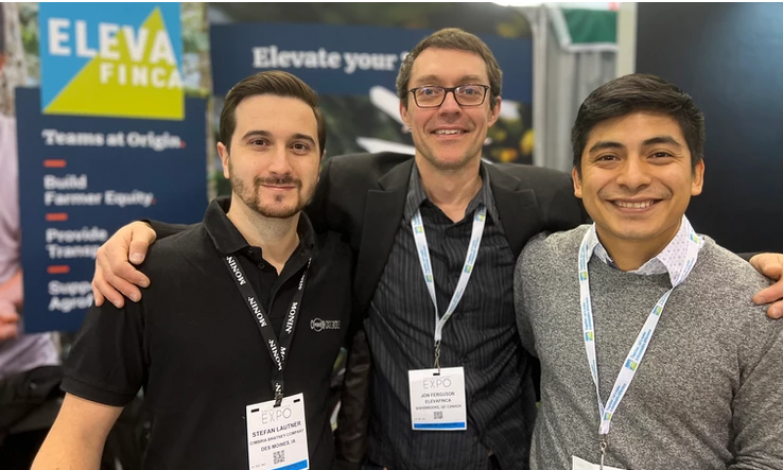
Stefan Lautner (Sales Manager at Cimbria), Jon Ferguson & Erly Camizan (from ElevaFinca) at the SCA Expo in Boston.
As we begin the new harvest season in Peru, the Café Selva Norte dry mill prepares to process their first full harvest season for cooperatives and clients near Jaen, Peru. As of September 2021, the Cimbria-equipped dry mill has provided a much-needed resource to the cooperatives and coffee organizations across Cajamarca and Amazonas.
For a further look into how coffee is processed and prepared for exportation at
the Café Selva Norte dry mill, ElevaFinca reached out for an interview with
Stefan Lautner, the Cimbria Sales Manager in South America. Stefan has worked
for nearly a decade with Cimbria, now residing in Lima. He has played an integral
role in drafting documentation and overall planning, installation, and
technical support for Cimbria machinery installed at the Café Selva Norte dry
mill.
During our interview with Stefan, we discussed the steps involved
for processing coffee, along with the machinery and technology used for
accomplishing each activity. The following provides an overview of the flow of
coffee from the time it is received at the mill to the time that coffee is
loaded onto a container for exportation.
Stefan Lautner (Sales Manager at Cimbria), Jon Ferguson & Erly
Camizan (from ElevaFinca) at the SCA Expo in Boston.
Arriving at the Mill
Prior to parchment arriving at the dry mill, most of the coffees
have received several layers of quality control analysis including moisture
content, physical grading, screen size, and cup quality. Once the cooperative
or client has finalized specifications for each coffee delivery, the machinery
is calibrated to achieve the highest output of their desired quality
specifications.
Stage 1: Cleaning
As the coffee enters the facility, the top screen of the
pre-cleaner removes the dust, debris, and dry cherries. The bottom screen
removes broken beans, smaller stones, and sand.
Stage 2: DestonerAfter the cleaning of the
parchment, the coffee passes through a destoner, removing larger rocks, pieces
of concrete, and all foreign matter which has a higher density than the coffee
being processed.
Stage 3. Huller
Coffee parchment is much like the shells still attached to a
peanut. The huller removes the outer brittle parchment shell from the coffee
seed (i.e., bean). Once the parchment is removed, the coffee is polished to remove
a layer of silver skin that lightly blankets the bean. In washed Peruvian
coffees, processors and buyers typically request highly polished coffee with no
silver skin attached.
Stage 4. Screen Size
After polishing, the coffee passes through several layers of screens to sort the coffee by bean size. The main goal for sorting by seed size at this stage is to prepare the coffee for sorting by density. If coffee is not screened and sorted by size prior to density sorting, there would be a greater loss of product, as density separation uses air pressure and turbulence to sort similar-sized beans into different levels of density. With a uniform size on each gravity table, the process will be much more precise and efficient.
Comment Now